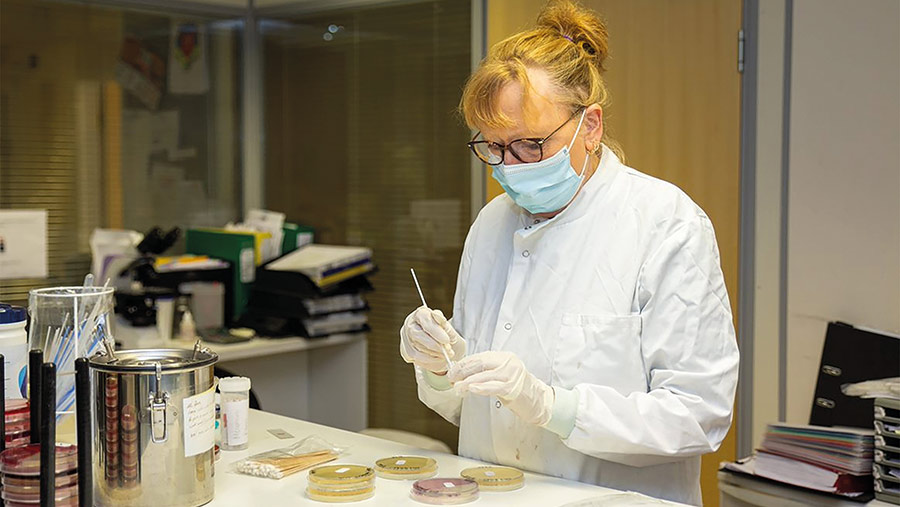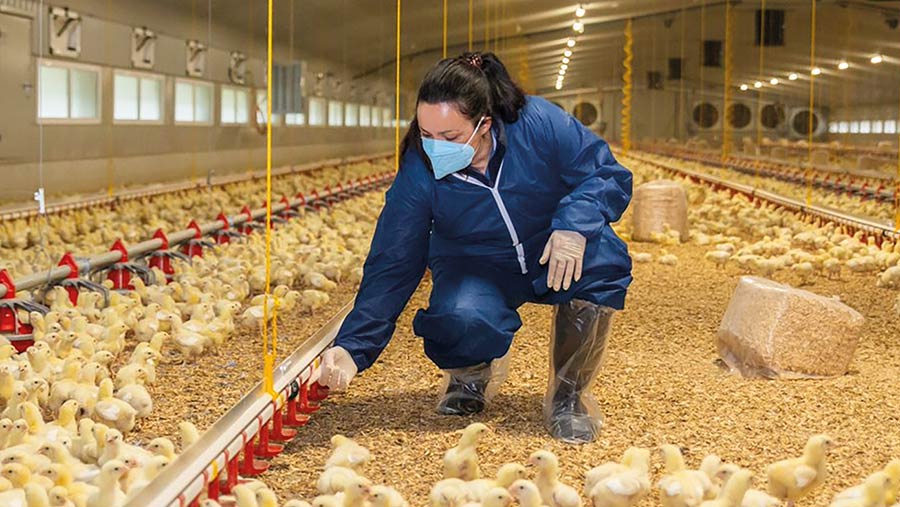Preventative lab testing for broilers – is it worth it?
 © Poultry Health Services
© Poultry Health Services Preventing disease or tackling it early can lead to significant savings in the long run. But adding cost to any system needs to be justified.
So, what is preventative laboratory testing, and do the benefits support the investment?
“Preventative testing is precautionary routine testing that is carried out when birds appear healthy,” explains Sara Perez, veterinary director at Poultry Health Services.
“It’s normally part of a tailored programme that considers site- or system-specific health challenges, helping prevent, or at least recognise, issues at an early stage.
This allows them to be tackled in a timely and cost-effective manner, or to optimise interventions like vaccination.”
See also: How biofilms can improve litter quality and bird health
The tests
There are several things to consider when designing a preventative testing programme. Decisions should be largely based on site-specific factors, which include the health status of the farm and previous flocks, an existing health plan and vaccine protocol, says Ms Perez.
“It’s crucial when building any preventative programme to consult closely with your vet. There are a lot of tests, but from a cost-benefit perspective, it’s important to pick those that are the most relevant for what you want to achieve.”
Testing should start before chicks arrive, she explains. “To begin with, we focus on preventing infection in the first seven days of chicks arriving on-farm, which is when birds are most vulnerable.”
Environmental testing
The first test is a general environmental hygiene swab, says Ms Perez.
“This takes place before chicks arrive, and uses a swab or gel bar method, known as a dipslide, to check total bacterial counts around the environment in which the birds will be reared.”
Crucial to the accuracy of this test is understanding how long it will take for the sample to arrive at the lab. If a producer can ensure a sample arrives within 24 hours, a standard swab is acceptable.
If it might take two to three days, a dipslide must be used.
“Environmental testing should be done around day five after emptying sheds, and prior to terminal disinfection and litter going down,” says Ms Perez.
“This should give the farmer an opportunity to make any changes needed to further improve cleanliness.
“Though, with turnarounds being very tight in the broiler sector, and if litter has already been put in the shed post-swabbing, then a smoker/fumigation clean can be undertaken.”
Water testing
Water hygiene testing should be carried out in parallel with environmental testing, says Ms Perez.
“Whether you’re on a borehole supply or mains water, it’s important to understand how crucial clean water is when introducing vulnerable chicks.
“Borehole water quality can vary quite considerably. For example, during last year’s drought, we saw high nitrate levels, which can have a production-limiting effect.
Preventative testing can catch this kind of issue before performance is affected.

Sara Perez © Poultry Health Services
“Water supplies should be tested at source and at the end of drinking lines prior to stocking sheds, then, if possible, every 14 days throughout the lifecycle of a crop,” she adds.
“Test for total viable counts – which will tell you the total level of bacteria in the water – and pseudomonas, which will indicate biofilm levels.
“If the farm has a history of enterococcus or staphylococcus, you can also include a test for those.”
Farmer Harry Shepherd, who has about one million birds on the ground at his units near York, was experiencing issues with femoral head necrosis (FHN), which affects birds’ legs.
“We used diagnostic testing to identify the issue, eventually finding a problem with the borehole water, which contained excessive amounts of iron and magnesium,” he explains.
“We made the switch to mains water, introduced a hydrogen-peroxide sanitising system, which runs at 50ppm, and have been sure to implement a preventative testing programme to catch any problems before performance is affected.
“The issues with the borehole not only manifested in the FHN problem, but also compromised gut integrity. It was an expensive lesson.”
Coccidiosis testing
Coccidiosis can compromise intestinal integrity and feed conversion ratios (FCRs). When setting up a preventative sampling programme, the first crop should be monitored through faecal egg counting.
The counts are plotted on a graph, in combination with feed and water intake information. Using this data, it can be predicted when subsequent flocks are likely to experience the greatest coccidiosis challenge.
Monitoring then continues through each batch, which benefits following crops.
“In the initial phase of a preventative monitoring programme, we take samples twice weekly from day seven to day 28 for the first flock,” explains Ms Perez. “This shows us when birds are experiencing peak challenge.
“As we continue monitoring and move through crops, we can forecast when each subsequent flock is likely to experience peak coccidiosis challenge.
“We then know when birds should be left alone, so changes to feed, vaccinations or any other disturbance are avoided. And, if necessary, we can intervene medically before the problem impacts production.”
Mr Shepherd is monitoring for coccidiosis, taking dropping samples at seven, 14, 21 and 28 days to develop a picture of when his flocks are most challenged, with the option to intervene if needed.
“We’ve seen improvements in overall health, FCRs and litter management – all positively affecting our bottom line.”
Blood testing
Another tool in the preventative testing toolbox comes in the form of predictive blood testing. The tests help indicate when best to administer vaccines, explains Ms Perez.
“We recommend using predictive blood testing in relation to Gumboro vaccine programmes.
“We take blood from chicks the day they arrive on farm to measure the level of maternal antibodies they have for the disease. Depending on these levels, we can understand the optimal time to vaccinate.
“A producer should vaccinate when the level of maternal antibodies is low, but not so low as to leave the birds unprotected.
Also, now we’ve tested and understood antibody levels, the producer can choose to use a weaker yet just as effective Gumboro vaccine.
“This offers a direct financial benefit. The weaker vaccine is not only cheaper, but the birds experience less of an immune reaction, allowing them to put their energy into growing rather than immune response.”
For infectious bronchitis (IB) vaccination, screening birds at 39-40 days to better understand antibody levels, as well as the strains present, offers the opportunity to tailor a programme and underpin its effectiveness.
“Chicks will arrive on farm already having received one standard IB vaccination at the hatchery, and most producers will do a second,” says Ms Perez.
“But, to get the best protection, screening birds to determine the level of antibodies produced in response to the vaccinations, and to understand the IB strains specific to the farm, will enable a producer to opt for a vaccine that is most effective.
“Vaccine surveillance testing is funded directly by pharmaceutical companies, saving the farmer money. And using the best vaccine to tackle IB strains on individual farms offers substantial health and welfare, as well as production benefits.”
Production and financial benefits
It’s clear to both Ms Perez and Mr Shepherd that preventative testing offers positive outcomes in terms of production and return on investment.
“Managing health challenges through preventative testing, integrated screening and predictive testing aims to reduce overall stress on flocks, improve feed conversion ratios (FCRs), identify the right vaccines to use, and generally maximise growth potential of birds,” Ms Perez says.
“The key to continued high performance is recognising the value of preventative testing and maintaining it, even when everything is going well.”
Mr Shepherd agrees with this core principle: “Preventative testing has helped us understand the key factors affecting bird health and performance.”
“In relation to water monitoring, we’re estimating a 3-5p/bird improvement, and the coccidiosis testing has improved FCRs by 0.03-0.05 points.
“The value of continued preventative testing is obvious to us, especially when the benefits are applied across the six million-plus birds a year we produce.
“We’re confident that when issues arise again, we can tackle them early and protect the gains we’ve made.”
Average costs and potential profit in a 200,000-bird flock |
|
|
Costs |
|
| Water testing for total viable counts (TVCs) and pseudomonas (two samples) | £30 |
| Hygiene swabs for TVCs (six swabs) | £70 |
| Worm egg counts (two samples a week from two houses) | £260 |
| Gumboro and Infectious bronchitis (10 bloods from 2 houses, and 10 bloods from 2 houses) | £0 |
| Total costs | £360 |
|
Profits |
|
|
A reduction in feed conversion ratio of 0.15 points achieved by the above testing equals increase in margin over feed and chick |
1p/bird |
|
1p x 200,000 birds, plus savings on medication and bedding (less bedding is needed thanks to improved litter quality) |
£2,000 |
|
Net profit |
£1,640 |
